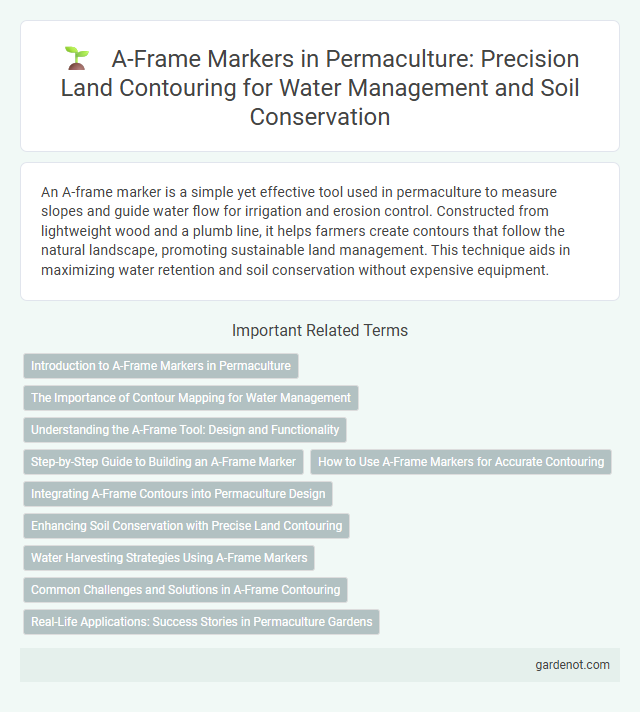An A-frame marker is a simple yet effective tool used in permaculture to measure slopes and guide water flow for irrigation and erosion control. Constructed from lightweight wood and a plumb line, it helps farmers create contours that follow the natural landscape, promoting sustainable land management. This technique aids in maximizing water retention and soil conservation without expensive equipment.
Introduction to A-Frame Markers in Permaculture
A-frame markers in permaculture serve as essential tools for measuring and establishing accurate land contours and measuring slopes, facilitating effective water management and erosion control. Crafted typically from lightweight wood or metal, these simple yet precise instruments help practitioners design swales, terraces, and other earthworks that promote soil health and biodiversity. Utilizing A-frame markers enhances the precision of site planning by visually representing elevation changes, ensuring sustainable landscape design that aligns with natural water flow.
The Importance of Contour Mapping for Water Management
Contour mapping is crucial in permaculture to design A-frame markers that accurately follow the land's natural slope, optimizing water distribution and reducing soil erosion. These markers help guide water flow to swales and keyline patterns, enhancing groundwater infiltration and improving overall soil health. Effective contour mapping maximizes water retention, supports plant growth, and sustains sustainable ecosystem functions.
Understanding the A-Frame Tool: Design and Functionality
The A-frame marker is a simple yet effective tool used in permaculture to measure and establish level ground for planting beds or terraces. Its design consists of two legs joined at the top with a horizontal crossbar that holds a plumb line, allowing users to determine the natural slope of the land accurately. Functionality centers on creating precise, contour-aligned markers that prevent soil erosion and optimize water retention in permaculture systems.
Step-by-Step Guide to Building an A-Frame Marker
Constructing an A-frame marker begins by selecting two wooden stakes approximately 4 feet long and securing them at the top with a crosspiece to form a sturdy triangular frame. Use a measuring tape to mark equal distances on a vertical string hung from the crosspiece, allowing accurate leveling when determining slope or contour lines in permaculture design. Paint or attach measurement markings on the string to enhance visibility and precision during land assessment and planning.
How to Use A-Frame Markers for Accurate Contouring
A-frame markers are essential tools in permaculture for establishing precise contour lines that guide water flow and soil conservation. By placing the A-frame on a slope and adjusting the crossbar until the water level is balanced, users can mark consistent elevation points across the landscape. This method ensures accurate contouring, maximizing erosion control and enhancing sustainable land management.
Integrating A-Frame Contours into Permaculture Design
Integrating A-frame contours into permaculture design enhances land management by accurately mapping slope gradients and natural water flow, promoting efficient soil conservation and erosion control. The A-frame tool, constructed from lightweight materials like wood or PVC, helps identify contour lines essential for placing swales, terraces, and berms to maximize water retention and plant health. Utilizing this method supports sustainable, regenerative agricultural practices by aligning planting strategies with the landscape's natural topography.
Enhancing Soil Conservation with Precise Land Contouring
A-frame markers serve as essential tools in permaculture for enhancing soil conservation through precise land contouring, enabling accurate determination of contour lines to reduce erosion and water runoff. By marking exact elevation points, farmers and gardeners can design swales and terraces that effectively retain water and promote nutrient-rich soil stability. This method supports sustainable land management practices by maximizing water infiltration and minimizing topsoil loss.
Water Harvesting Strategies Using A-Frame Markers
A-frame markers provide a simple yet effective tool for designing water harvesting contours in permaculture landscapes by accurately identifying the natural slope gradient and flow direction. These wooden or plastic frames, set perpendicular to the land's gradient, help create precise key lines for positioning swales, terraces, and diversion channels that maximize rainwater infiltration and reduce erosion. Utilizing A-frame markers enhances water catchment efficiency by guiding earthworks that capture and slowly release water, promoting soil moisture retention and sustainable irrigation for diverse plant systems.
Common Challenges and Solutions in A-Frame Contouring
A-frame contouring in permaculture often faces challenges such as uneven ground measurement and obstacles like roots or rocks that disrupt accuracy. Solutions include regularly calibrating the A-frame tool, clearing debris before measurement, and using flexible measurement adjustments to account for natural terrain irregularities. Employing these techniques ensures precise contour lines essential for effective water retention and soil conservation.
Real-Life Applications: Success Stories in Permaculture Gardens
A-frame markers have proven essential in permaculture gardens for precise contour mapping and water management, leading to improved soil erosion control and crop yield. Gardeners in diverse regions report significant success using these simple tools to establish swales, ensuring efficient water distribution and reducing runoff. By integrating A-frame markers, permaculture projects optimize land use and promote sustainable, resilient ecosystems.
A-frame marker Infographic

 gardenot.com
gardenot.com